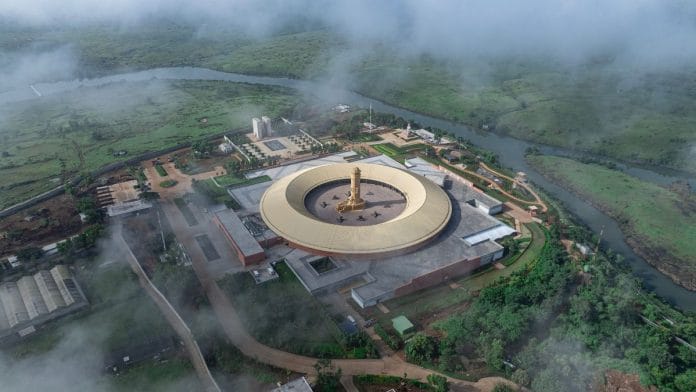Pune: A museum on the banks of the Indrayani River in Pune is giving a contemporary rendering of ancient Indian stories through the lens of Jainism. The Abhay Prabhavana Museum shows how the underlying values across different faiths are the same.
The museum, which traces the history and values of Jainism, was inaugurated in November 2024. It’s situated a few kilometres off the old Mumbai-Pune highway, and has been seeing about 350 visitors a day every weekend since.
“We used modern methods like animation, mechatronics and so on to show these values to today’s generation in an attractive manner,” Abhay Firodia, founder of Abhay Prabhavana Museum and Chairman of the Board at Force Motors, said.
A 43-foot marble statue of Rishabdev, the first Tirthankar (spiritual teacher), faces the east to meet the rising sun. In Jainism, Tirthankar, means ‘maker of a ford’—the one who creates a path across the river of life and death.
The statue is sculpted in an art deco style with bold geometric patterns and clean lines, setting the tone for what the museum aims to do—modernise stories from ancient India.
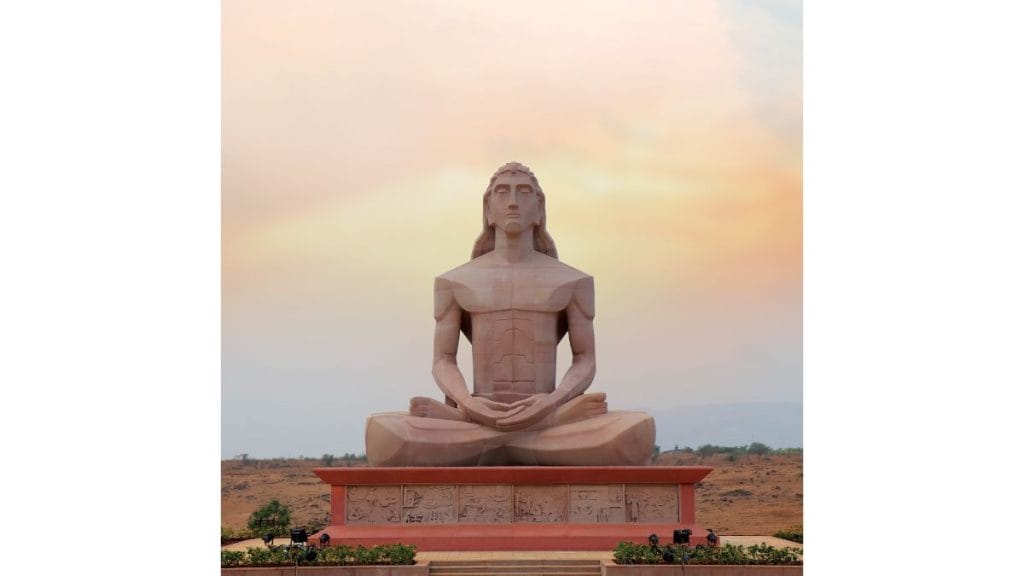
“I did not want to portray Rishabdev in the normal style of a Jain Tirthankar, where he is shown as having attained his liberation. I wanted to show him as an energetic person,” said Firodia.
There are about 4.5 million Jains in India, as per the 2011 census. A third of them live in Maharashtra, particularly the state’s western parts. The rest are spread across states such as Rajasthan, Madhya Pradesh, Gujarat and Karnataka. The museum has influences from each of these states.
Thirty galleries span over a built-up area of 3.5 lakh square feet spread over 50 acres. A lotus pond sits across from the main entrance that takes you into an expansive main hall, overlooking a courtyard. A 100-feet manstambh, a pillar assembled with 4,150 pieces of Jaisalmer stone in seven intricately carved layers, sits in the courtyard.
Also read: JJ School of Arts is a museum in itself. Heritage walk explores its history
12 years in the making
Two different interactions inspired Firodia to conceptualise the museum.
One was with Acharaya Chandanaji Swami, a prominent Jain Sadhvi, who was keen on preserving the Indian value system. The other was with the Dalai Lama, whose quote appears prominently in the gallery on thinkers, “Religion is the process of enhancing faith in values.”
While researching, it became clear that while the focus is on values, the story of how the civilisation grew needed to be told.
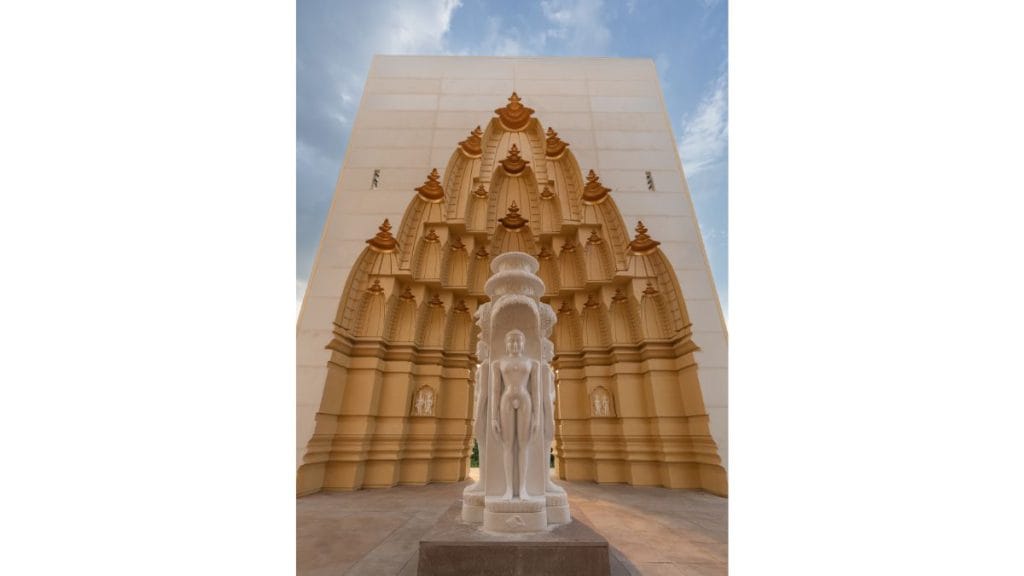
Scholars and academicians took twelve years to collect, distill and present the information. The visitors, Firodia said, will have to put in just as much effort to fully understand what the museum stands for and take away something meaningful from it.
“Nobody can see this museum in its entirety, read every script and see every show in less than two days, and even that may not be enough,” he said.
He expects it to be perfectly normal that only 50 per cent of the youth who visit the museum will be really interested in the message.
“If thousands of students over the years come here and this leads to a population of people who are introduced to our values, who have tried to understand them and are encouraged by them, then we have made good progress,” Firodia said.
Also read: Made in haste, built at wrong place, no footfall—India’s site museums are a sad story
Reconstructions of caves
Along the riverfront, scale models of temples and sculptures trace the evolution of India’s spiritual and architectural traditions.
“Temples started with caves, then they became cave temples, then they became elaborate built temples,” Firodia said.
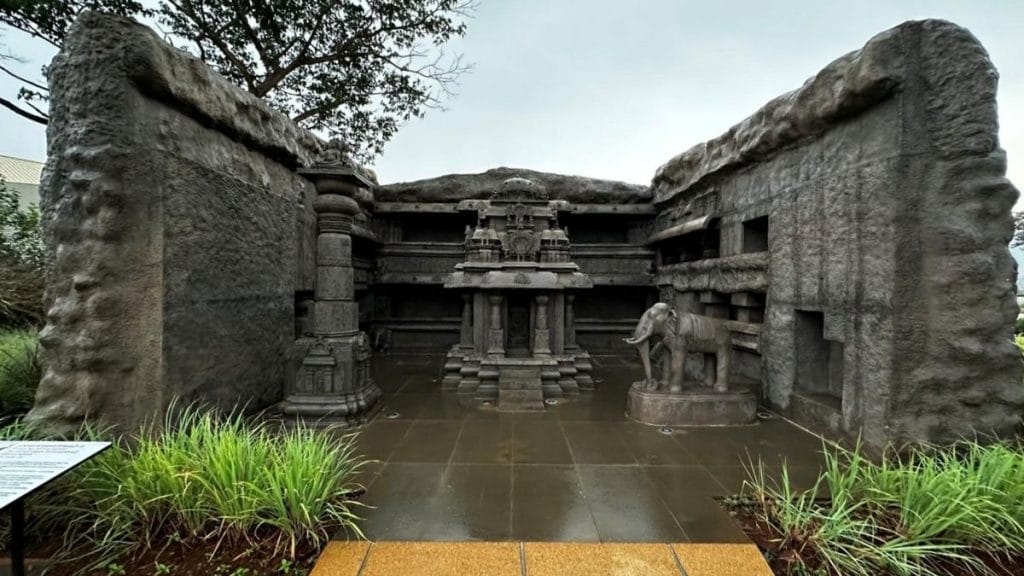
On the walls on either side of the main hall are Pichwai paintings that introduce concepts housed in the museum, almost functioning like a pictorial index for what is inside. A painting of the battle between Rani Abbakka Chowta, a Tulu queen of Ullal (in present-day Karnataka) and the Portuguese in the 16th century sets the tone for the concept of Asi. Asi refers to swordsmanship, and was one of the six main professions taught by Rishabnath, the first Tirthankar. The queen’s 500th birth anniversary was celebrated in March 2025.
Among the larger installations in the galleries are reconstructions of the Badami caves, finely carved temple pillars from Rajasthan and the Bahubali statue from Gommateshwara.
The Hoysala section features a distinctive lathe-turned pillar, known for its circular finish and detailed workmanship. A waiting hall has a scaled model of a Jain stupa entrance that draws its design from an Ayagapata stone tablet found at Kankali Tila in Mathura.
Goddess Saraswati, a central figure in Jain mythology, also worshipped by Hindus, is a recurring theme— she’s in the Pichwai paintings in the main reception hall and there’s a fine-scale replica of her statue in Pallu, Rajasthan.
The figurine holds a book for wisdom, a rosary for meditation, a lotus for purity, and a water pot for life and renewal. The piece has intricate work on the pillars and archways with musicians playing the veena and the flute, and attendants holding garlands.
“Saraswati is the prime Goddess in Jainism. From Rani Abbakka to Attimabbe, Jain women have contributed to safety and security,” noted Firodia.
Also read: Humayun pioneered architecture, art, and astronomy. Now he’s got his own museum
Letting it go
Three hundred and fifty artworks, sculptures, replicas, animations and immersive experiences come together to create this whirlwind tour of Indic civilisation that entertains, informs and provokes thought.
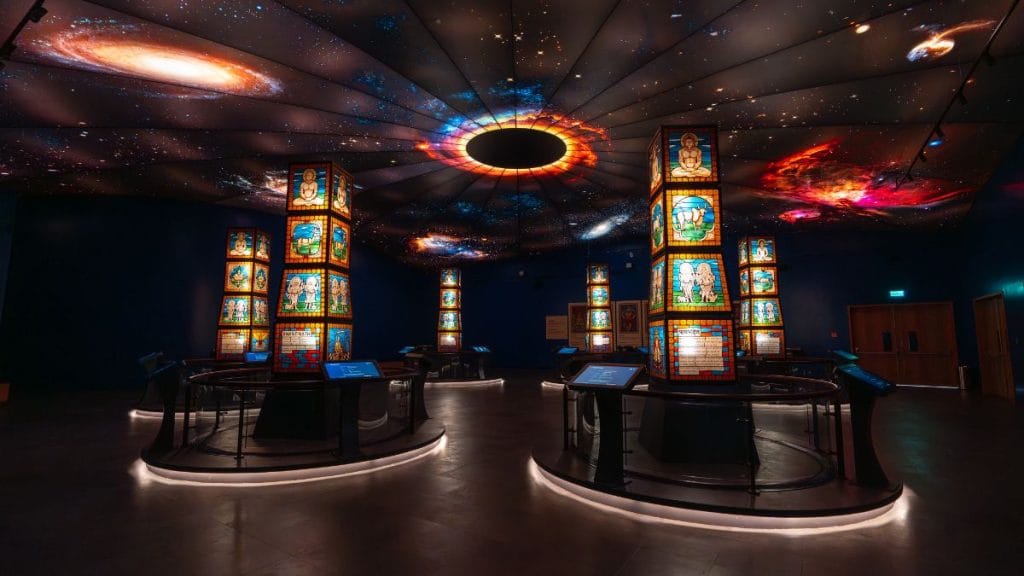
“Teachings of the tirthankaras are well presented in the museum. They speak directly to the intellect, are simple and doable. They help lead a more fulfilling life,” Sneha Patil, a visitor to the museum, said.
An entire room is dedicated to the concept of Anekantvad (or multiplicity of views). According to Firodia, “overcoming divisiveness, not just of caste, but also traditions, is key”. On the wall is a lenticular art piece with the visitor seeing shades of red and green from either side. On the opposite wall, a mirror installation delivers the same message.
The inner section of the museum concludes with a multimedia installation called ‘Letting it Go’. You can select the feelings and vices that you want to let go on a touchscreen. These translate into a multicoloured boat in front of your eyes. The boat then slowly floats away beneath your feet.
“Values are permanently enduring,” the founder said. “There is no value that is ancient, and there is no value that is modern. If it is a value, it is continuous.”
(Edited by Theres Sudeep)



